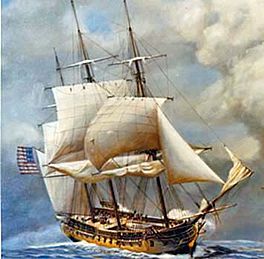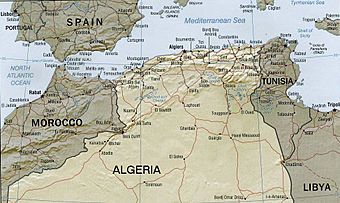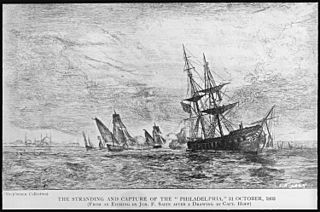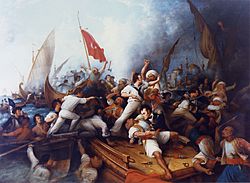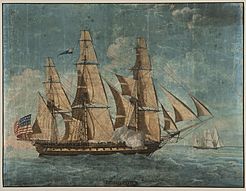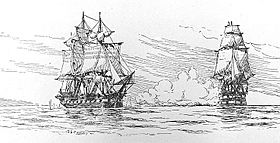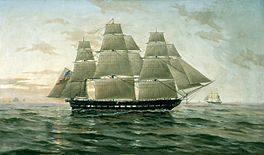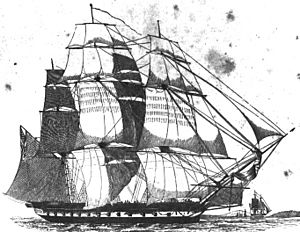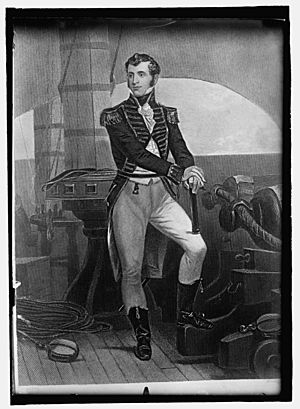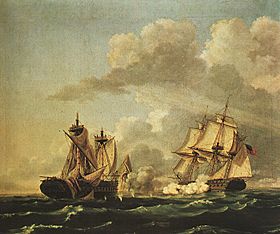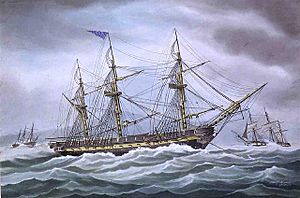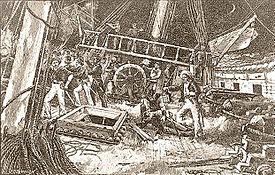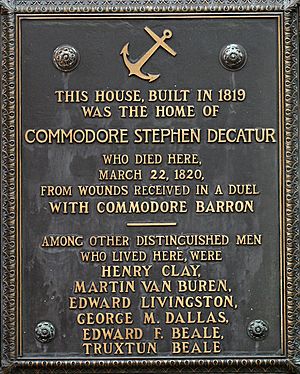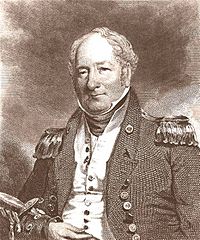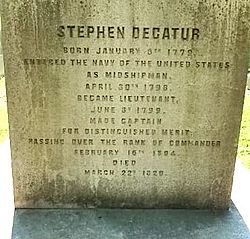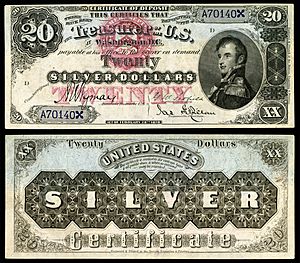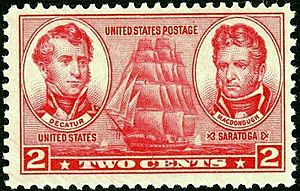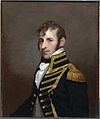Stephen Decatur facts for kids
Quick facts for kids
Stephen Decatur
|
|
|---|---|
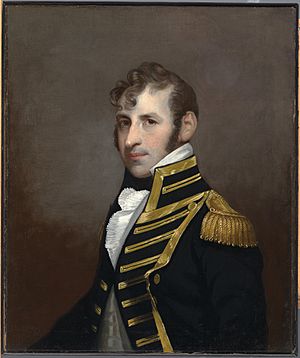
Portrait by Charles Bird King
|
|
| Birth name | Stephen Decatur Jr. |
| Born | January 5, 1779 Sinepuxent, Maryland |
| Died | March 22, 1820 (aged 41) Washington, D.C., U.S. |
| Buried |
St. Peter's Episcopal Church, Philadelphia, Pennsylvania, U.S.
|
| Branch | United States Navy |
| Years of service | 1798–1820 |
| Rank | Commodore |
| Commands held | |
| Battles/wars | |
| Awards | Congressional Gold Medal |
| Spouse(s) |
Susan Wheeler
(m. 1806) |
| Other work | Board of Navy Commissioners |
Stephen Decatur Jr. (January 5, 1779 – March 22, 1820) was a very brave American naval officer. He became a commodore, a high rank in the navy. He was born in Worcester County, Maryland. His father, Stephen Decatur Sr., was also a naval officer. He taught young Stephen about ships and sailing from an early age.
Decatur joined the U.S. Navy when he was nineteen. He quickly became known for his courage. At just 25 years old, he became the youngest captain in U.S. Navy history. He served under three presidents. He helped the U.S. Navy become a strong force in the world. He fought in the Barbary Wars in North Africa, the Quasi-War with France, and the War of 1812 against Britain. He was famous for being a great leader. He also truly cared about the sailors who served under him.
Decatur won many naval battles. These victories helped show that the United States Navy was a rising power. He commanded many ships and later joined the Board of Navy Commissioners. He built a large home in Washington, D.C., called Decatur House. It was a center for social life in Washington in the early 1800s.
Decatur's life ended early when he was killed in a duel with another officer, Commodore James Barron. This happened after Decatur refused to take back comments he made about Barron's actions in the Chesapeake–Leopard affair of 1807. Even so, Stephen Decatur became a national hero during his lifetime. He was the first American hero after the American Revolutionary War.
Contents
- Early Life and Learning
- Joining the Navy
- Fighting in the Quasi-War
- First Barbary War Battles
- Marriage and Shipbuilding
- The Chesapeake–Leopard Affair
- Commanding the USS Chesapeake
- Commanding the USS United States
- War of 1812 Battles
- Second Barbary War Success
- Life at Home
- Decatur's Death
- Legacy and Remembrance
- Images for kids
- See also
Early Life and Learning
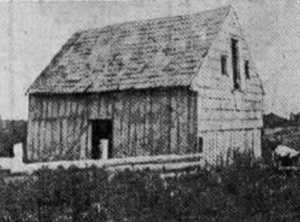
Stephen Decatur was born on January 5, 1779. His birthplace was Sinepuxent, Maryland. His father, Stephen Decatur Sr., was a merchant captain. He later became an officer in the new American navy. His mother was Ann (Pine) Decatur. Stephen's father's family was French, and his mother's family was Irish.
His parents had moved from Philadelphia just three months before Stephen was born. They had to leave Philadelphia because the British army took over the city during the American Revolution. Later, they returned to Philadelphia. Stephen grew up there and went to the Episcopal Academy.
Decatur developed a love for the sea in an interesting way. When he was eight, he got a bad case of whooping cough. People at that time thought that sea air could help. So, Stephen went with his father on a merchant ship to Europe. Sailing across the Atlantic Ocean and back helped him get completely better. After this trip, Stephen was very excited about sailing. He often talked about wanting to go to sea.
His parents, especially his mother, had different plans for him. His mother hoped he would become a clergyman. They tried to make him focus on his studies.
Decatur went to Woodbury Academy in Woodbury, New Jersey. Then, his father sent him to the Episcopal Academy. This was a school for boys that taught Latin, math, and religion. Stephen did not study hard there and barely graduated. In 1795, he went to the University of Pennsylvania for one year. There, he studied harder and focused more. He met Charles Stewart and Richard Somers at the university. They later became naval officers too.
Decatur found his studies boring. He did not like university life. At 17, he decided to leave school. He wanted to work with ships and the sea. His parents were not happy, but they let him follow his dream. His father helped him get a job at Gurney and Smith, a shipbuilding company. Stephen helped supervise the building of the frigate United States. He was a midshipman on this ship when it was launched on May 10, 1797. Commodore John Barry commanded the ship.
Before the Quasi-War with France, the U.S. Congress decided to build a navy. This was to protect American trade and ships. On March 27, 1794, they passed a law to build six frigates. President George Washington signed it.
Work on the ships stopped for a while when peace was made with Algiers. But President Washington insisted that work continue on three ships. These were USS United States, USS Constellation, and USS Constitution.
In 1798, John Barry helped Decatur become a midshipman on the United States. Barry was a hero from the Revolutionary War and a good friend to Decatur. Decatur started his naval career on May 1. He learned a lot about naval warfare from Barry and James Barron. Both officers liked Decatur.
Decatur's father hired a tutor, Talbot Hamilton, to teach his son about navigation. Hamilton was a former officer from the Royal Navy. So, Decatur received excellent training. He learned from Hamilton and from serving on a real ship. This made him stand out from many other young officers. He also enjoyed drawing ships and building ship models.
Fighting in the Quasi-War
After America became independent, it no longer had Britain's protection. So, it needed to protect its own ships. There were few American ships to defend the coast or merchant ships abroad. France was angry that America traded with Britain. France was also upset that America refused to pay a debt to the French crown. Because of this, France started capturing American ships.
President John Adams then appointed Benjamin Stoddert as the first Secretary of the Navy. Stoddert ordered his commanders to capture any French armed vessels. At this time, the American Navy was not as strong as European navies.
On May 22, 1799, President John Adams promoted Decatur to lieutenant. This was after he served more than a year as a midshipman on the frigate United States. While the United States was being repaired, Decatur stayed in Philadelphia. His job was to find and gather a crew for the ship.
One day, a chief mate from another ship insulted Decatur and the U.S. Navy. Decatur remained calm and left. But his father told him that the family's and Navy's honor had been insulted. He said Stephen should challenge the man to a duel. Decatur was a very good shot with a pistol. He told his friend, Lieutenant Charles Stewart, that he would only wound his opponent in the hip. And that is exactly what happened. Both men's honor was satisfied, and no one died.
By July 1, 1799, United States was ready. It began patrolling the south Atlantic coast and West Indies. It looked for French ships that were attacking American merchant vessels. After this mission, the ship went to Norfolk, Virginia, for repairs. Then it sailed to Newport, Rhode Island, arriving on September 12.
Commodore Barry received orders to take two U.S. envoys to Spain. On December 3, the United States sailed for Lisbon through England. The ship faced strong winds. The envoys were dropped off in England. On April 3, 1800, the ship returned to the Delaware River. It had been damaged by the storms. The ship went to Chester, Pennsylvania, for repairs.
Decatur did not want to wait during the repairs. He transferred to the brig USS Norfolk. In May, the Norfolk sailed to the West Indies. It patrolled for French privateers and warships. Over the next few months, 25 enemy ships were captured or destroyed. The Norfolk then escorted merchant ships back to the United States.
Decatur returned to the United States by June 1800. His former classmates, Lieutenant Charles Stewart and Midshipman Richard Somers, were also on board. Lieutenant James Barron was there too.
After the Quasi-War, the U.S. Navy became much smaller. Many ships and officers were removed. But Decatur was one of the few chosen to stay in the Navy. By 1801, the American Navy had 42 ships. This included USS President, Constellation, and USS Chesapeake.
First Barbary War Battles
The first war against the Barbary States happened because pirates often attacked American ships. They would capture American crews in the Mediterranean Sea. Then they would hold them for huge ransoms. President Thomas Jefferson usually did not like having a large army or navy. But he sent U.S. naval forces to fight the Barbary states. He did not want to keep paying large amounts of money to these North African kingdoms.
On May 13, 1801, Decatur was assigned to the frigate USS Essex. He served as the first lieutenant. The Essex had 32 guns. It was part of Commodore Richard Dale's squadron. This squadron also included USS Philadelphia, President, and USS Enterprise. They left for the Mediterranean on June 1. This was the first American naval squadron to cross the Atlantic Ocean.
On July 1, the squadron sailed into the Mediterranean. Their mission was to confront the Barbary pirates. At Gibraltar, Commodore Dale learned that Tripoli had already declared war on the United States. There were two large Tripolitan warships in Gibraltar's harbor. Their captains claimed they did not know about the war. Dale thought they were planning to attack American merchant ships in the Atlantic. Dale ordered the Philadelphia to stay behind and guard the Tripolitan vessels.
In September 1802, Decatur moved to the 36-gun frigate USS New York. He was the first lieutenant under Commodore James Barron. On their way to Tripoli, the squadron faced strong winds for over a week. They had to stop in Malta. While there, Decatur had a fight with a British officer. This led to Decatur returning to the United States.
Back home, he took temporary command of the new 18-gun brig USS Argus. He sailed it to Gibraltar. There, he gave command to Lieutenant Isaac Hull. In return, Decatur was given command of Enterprise, a 12-gun schooner.
On December 23, 1803, Enterprise and USS Constitution met the Tripolitan ketch Mastico. It was sailing under Turkish colors. It only had two guns and no passports. It was going from Tripoli to Constantinople. After a short fight, Decatur and his crew captured the ship. They killed or wounded the few men defending it. The small ship was taken to Syracuse. Commodore Edward Preble declared it a prize of war. It was renamed USS Intrepid.
Burning of the USS Philadelphia
On October 31, 1803, the Philadelphia, commanded by Commodore William Bainbridge, got stuck on a hidden reef near Tripoli's harbor. After trying hard to get it free, the ship was captured. Its crew was taken prisoner by Tripolitan forces.
Decatur came up with a daring plan. He sailed to Tripoli with 80 volunteers, mostly U.S. Marines. He planned to enter the harbor with Intrepid without being noticed. Their goal was to board the captured frigate Philadelphia and burn it. This would stop the pirates from using it. USS Syren, commanded by Lieutenant Charles Stewart, went with Intrepid. It would provide support during the attack. Eight sailors from Syren joined Intrepid. This included Thomas Macdonough, who knew the Philadelphia's layout well. Decatur and Macdonough became close friends.
On February 16, 1804, at 7:00 PM, Intrepid slowly sailed into Tripoli harbor. The moon was a thin crescent, giving little light. Decatur's ship looked like a common merchant ship from Malta. It flew British flags. To avoid suspicion, five Sicilian volunteers were on board. One of them, Salvatore Catalano, spoke Arabic. The boarding party hid below deck, ready to attack. The men were split into groups. Each group had a specific area of the Philadelphia to secure. They were told not to use guns unless absolutely necessary.
As Decatur's ship got closer, Catalano called out to the harbor guards in Arabic. He said their ship had lost its anchors in a storm. They were seeking shelter in Tripoli for repairs. By 9:30 PM, Decatur's ship was within 200 yards of Philadelphia. The Philadelphia's lower masts were resting on the deck. Its front mast was missing. Bainbridge had ordered it cut away to lighten the ship, but it didn't work.
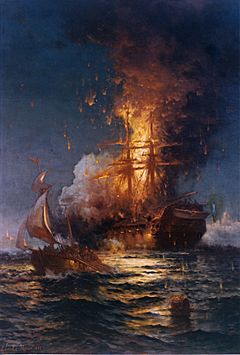
by Edward Moran (1897)
Intrepid depicted in foreground
As Decatur approached, a light wind made his approach slow. He had to carefully position his ship close enough to Philadelphia without raising suspicion. When the two ships were finally close, Catalano got permission for Decatur to tie Intrepid to the captured Philadelphia. Decatur surprised the few Tripolitans on board. He shouted "board!" This signaled his hidden crew to come out and storm the ship.
Decatur and 60 of his men, dressed as Maltese or Arab sailors, boarded the Philadelphia. They were armed with swords and pikes. They took back the ship in less than 10 minutes. They killed at least 20 Tripolitan crew members. One wounded crewman was captured. The rest jumped overboard. Only one of Decatur's men was slightly wounded.
There was hope they could sail the captured ship away. But the Philadelphia was too damaged. Decatur realized Intrepid could not tow the larger warship out of the harbor. Commodore Preble's order was to destroy the ship if it couldn't sail. With the ship secured, Decatur's crew placed flammable materials around the Philadelphia. They set it on fire. After making sure the fire was big enough, Decatur ordered his men to leave. He was the last one to leave the Philadelphia.
As the flames grew, the guns on Philadelphia heated up and began firing. Some shots hit the town and shore batteries. The ropes holding the ship burned, and it drifted onto rocks at the harbor entrance.
While Intrepid was under fire from Tripolitans on shore and in small boats, the larger Syren provided covering fire. It shot at the Tripolitan shore batteries and gunboats. Decatur and his men escaped the burning ship and sailed to the open sea. They barely got away in the confusion. Under the cover of night, Intrepid and Syren returned to Syracuse. They arrived on February 18.
When British Vice Admiral Lord Horatio Nelson heard about Decatur's daring act, he said it was "the most bold and daring act of the Age." Decatur's successful burning of the Philadelphia made him an instant national hero in the U.S. At Naples, Decatur was called "Terror of the Foe" by the local news. Pope Pius VII publicly praised the U.S. He said that America, though young, had done more to humble the "anti-Christian barbarians" in one night than all European states had done for a long time. Upon returning to Syracuse, Decatur took command of Enterprise again.
Second Attack on Tripoli
After burning the Philadelphia, Commodore Preble believed peace with Tripoli was possible. He planned another attack. He gathered a squadron of ships. This included the frigate Constitution, the brigs Syren, Argus, and Scourge. It also had the schooners Nautilus, Vixen, and Enterprise. They towed gunboats and ketches.
Preble borrowed six gunboats from King Ferdinand I. The king was also at war with Tripoli. Small ships were needed for the shallow waters of Tripoli's harbor. On August 3, 1804, they entered the west end of Tripoli harbor. They began attacking Tripoli.
Preble divided his gunboats into two groups. He put Decatur in charge of the second group. At 1:30 PM, Preble gave the signal to attack. The attack was well-planned. Brigs, schooners, and bomb ketches joined at different times. The Tripolitan pasha, Murad Reis, was ready for the attack. He had his own gunboats waiting in the harbor.
Throughout August 1804, Preble launched many fierce attacks on Tripoli. This forced the residents to flee to the countryside. During this time, Decatur, commanding the gunboats, captured three Tripolitan gunboats. He also sank three others. The Tripolitans also damaged some American ships. Decatur's ship was hit by a 24-pound shot above the waterline.
Before the battle ended, USS John Adams arrived. It was commanded by Isaac Chauncey. On board were documents promoting Decatur to the rank of captain. The John Adams also brought news. Because the frigate Philadelphia was lost, the government was sending four more frigates. These were President, Congress, Constellation, and Essex. They would bring enough force to make the Pasha of Tripoli agree to peace. Preble's rank was not high enough to command this larger force. So, he had to give command to Commodore Barron.
The fighting and bombing of Tripoli lasted three hours. Preble's squadrons won. However, Decatur's success was overshadowed by a sad event. During the fighting, Decatur's younger brother, James Decatur, was badly wounded. A Tripolitan captain shot him after pretending to surrender. Midshipman Brown, who was with James, escaped and told Stephen.
Stephen Decatur had just captured his first Tripolitan ship. When he heard about his brother, he gave command of his captured ship to Lieutenant Jonathan Thorn. He immediately went to avenge his brother. He caught up with the Tripolitan ship and was the first to board it. Midshipman Macdonough and nine volunteers followed him. Decatur and his crew were outnumbered 5 to 1. But they fought bravely.
Decatur quickly found the corsair captain who shot his brother. The captain was a large man in Muslim clothes. He attacked Decatur with a pike. Decatur used his cutlass to block the attack, but his cutlass broke. During the fight, another Tripolitan tried to kill Decatur. But Daniel Frazier, a wounded crewman, threw himself over Decatur. He took the blow meant for Decatur. The fight continued. The Tripolitan captain was bigger and stronger. He got the upper hand. He tried to stab Decatur with a dagger. But Decatur wrestled his arm. He managed to grab his pistol and fired it at close range. He killed his enemy instantly. When the fighting ended, 21 Tripolitans were dead. Only three were captured alive.
Later, James Decatur was taken aboard the Constitution. His brother Stephen stayed with him until he died. The next day, after a funeral led by Preble, Stephen Decatur saw his brother's body buried at sea.
After many days passed without the promised ships, Preble renewed the attack on Tripoli on August 24. Tripoli still showed no signs of surrendering. Preble then came up with another plan. The Intrepid, the same ship that captured Philadelphia, was loaded with gunpowder. It was sent sailing into a group of Tripolitan ships. Lieutenant Richard Somers commanded it, with Midshipman Henry Wadsworth and eleven volunteers. The plan was to place the ketch among the enemy ships, light the fuses, and escape. But something went wrong. The ship exploded before reaching its target, killing everyone on board.
The siege of Tripoli, along with the capture of the Derna fortress by U.S. Marines, was successful. This finally made the Bashaw of Tripoli consider surrendering. He agreed to return the American prisoners, including Commodore Bainbridge of the Philadelphia. Bainbridge had been held prisoner since October 1803. On June 4, 1805, the Bashaw of Tripoli finally surrendered. He signed a peace treaty with the United States.
Command of USS Constitution
Soon after he recaptured and destroyed the Philadelphia, Decatur was given command of the frigate Constitution. He held this command from October 28 to November 9, 1804. On the day Decatur returned with Intrepid, Commodore Preble wrote to the Secretary of the Navy. He recommended that President Jefferson promote Decatur to captain. Decatur was promoted to captain on February 16, 1804. He was only twenty-five years old. This made him the youngest person ever to hold that rank. This promotion was mainly for his brave capture and destruction of the Philadelphia in Tripoli's harbor.
On September 10, 1804, Commodore Barron arrived at Tripoli with two ships, President and Constellation. Commodore Preble then gave command of his squadron to Barron. Before returning to the United States, Preble sailed to Malta in the Constitution on September 14. The ship needed to be repaired. From there, he sailed to Syracuse in Argus. On September 24, he ordered Decatur to sail Argus back to Malta to take command of Constitution.
From Malta, Decatur sailed Constitution back to Tripoli. He joined Constellation and Congress, which were blocking the harbor under Commodore Barron. On November 6, he gave command of Constitution to Commodore John Rodgers, who was his senior officer. In return, Decatur took command of the smaller vessel Congress. Rodgers sailed Constitution to Lisbon for repairs.
Marriage and Shipbuilding
On March 8, 1806, Decatur married Susan Wheeler. She was the daughter of Luke Wheeler, the mayor of Norfolk, Virginia. Susan was known for her beauty and intelligence in Norfolk and Washington society. They met at a dinner and ball hosted by the mayor. This event was for a Tunisian ambassador who was in the U.S. to negotiate peace.
Before marrying Susan, Decatur had promised to serve in the U.S. Navy. He believed that leaving his service for personal reasons would make him unworthy of her. Susan had been pursued by Vice President Aaron Burr and Jérôme Bonaparte, Napoleon's brother. She turned them both down. For several months after their marriage, the couple lived with Susan's parents in Norfolk. Then, Stephen received orders to go to Newport to supervise the building of gunboats. The couple never had children.
In the spring of 1806, Decatur was given command of a group of gunboats. They were stationed in the Chesapeake Bay at Norfolk, Virginia. He had wanted this job for a long time. Some thought he also wanted to be close to Susan Wheeler. While there, Decatur courted Miss Wheeler, whom he soon married.
After their marriage in March, Decatur lived with his wife's family in Norfolk. In June, Secretary of the Navy Robert Smith ordered him to supervise the building of four gunboats in Newport, Rhode Island. He also oversaw four others in Connecticut. He would later command these ships. Decatur was a natural choice for this job. He had drawn many ship illustrations and built ship models. He also had experience as a ship builder. He had overseen the construction of the frigate United States in 1797. Decatur and his wife Susan lived together during this time.
The Chesapeake–Leopard Affair
After finishing his work on the gunboats, Decatur returned to Norfolk in March 1807. He was given command of the Naval Yard at Gosport. While there, he received a letter from the British consul. The consul demanded that three sailors who had deserted from the British ship Melampus be handed over. These sailors had joined the American Navy.
Decatur refused to get involved. The matter was then sent to the British minister in Washington, Mr. Erskine. He demanded that the three deserters be given to British authority. It was found that the deserters were American citizens who had been forced to serve in the Royal Navy. Since the treaty with Britain did not cover military deserters, Commodore Barron also refused to hand them over.
Soon after, the Chesapeake left Norfolk. It stopped briefly in Washington for more preparations. On June 22, it sailed for the Mediterranean. Soon, it was chased by HMS Leopard. The Leopard was part of a British squadron in Lynnhaven Bay. When the Leopard got close, its captain told Barron that Vice-Admiral Humphreys demanded to search the Chesapeake for deserters. Barron found this demand very bold. When he refused, the Leopard opened fire.
The Chesapeake had just left port and was not ready for battle. It could not fire back. In less than twenty minutes, three of its crew were killed and eighteen wounded. Barron lowered the ship's flags and surrendered. The Leopard boarded the ship and took the alleged deserters.
News of this event quickly reached President Jefferson, the Navy Department, and Decatur. Decatur was very angry. This incident became known as the Chesapeake–Leopard affair. This event would later lead to a duel between Barron and Decatur. Decatur was part of Barron's court-martial (military trial). He was one of the strongest critics of how Barron handled the Chesapeake incident.
Commanding the USS Chesapeake
On June 26, 1807, Decatur was given command of the Chesapeake, a 38-gun frigate. He also commanded all gunboats at Norfolk. The Chesapeake had just returned to Norfolk after repairs from the Chesapeake–Leopard affair. Commodore Barron had been removed from command after his court-martial for the incident. Decatur was on that court-martial. It found Barron guilty of "unpreparedness" and banned him from command for five years.
Barron's orders to sail for the Mediterranean were canceled. Instead, the Chesapeake was assigned to Commodore Decatur. With a squadron of gunboats, he patrolled the New England coast. He enforced the Embargo Act through 1809. Since he could not command, Barron left the country for Copenhagen. He stayed there through the War of 1812. Before Decatur took command of Chesapeake, he learned that British ships were preparing to block Norfolk. He informed the Navy Secretary.
During this time, Decatur's father, Stephen Decatur Sr., died in November 1808 at age 57. His mother died the next year. Both parents were buried at St. Peter's Church in Philadelphia.
Commanding the USS United States
In May 1810, Decatur was appointed commander of the United States. This was a large frigate with 44 guns. It was the same ship he had helped build and where he started his naval career as a midshipman in 1798. The ship was ready for service at sea.
After taking command, Decatur sailed the United States to most naval ports on the eastern seaboard. He was well received at each stop. On May 21, 1811, he sailed from Norfolk with USS Hornet. They patrolled the coast and returned to Norfolk on November 23. In 1812, he sailed with Argus and Congress. But they were soon called back because of news about the war with Britain.
Decatur then joined Captain John Rodgers, who commanded President and his squadron. On this trip, Rodgers failed to stop a fleet of English merchant ships. On August 31, Decatur sailed United States to Boston. On October 8, he sailed on a second trip with Rodgers' squadron.
War of 1812 Battles
The desire for more land, the capture of American sailors by the Royal Navy, and British alliances with Native American tribes all led to the War of 1812. The Embargo Act, meant to avoid war, only made things worse. Finally, on June 18, 1812, the United States declared war on Great Britain. By 1814, Britain had nearly 100 warships along the American coast. So, the war was fought mostly at sea. Decatur and other naval officers played major roles in America's success.
When the war began, President James Madison ordered several naval ships to patrol the American coastline. The U.S. flagships President, Essex, and Hornet joined United States (commanded by Decatur), Congress, and Argus in New York harbor.
Three days after the U.S. declared war, a squadron left New York City. It was led by Commodore John Rodgers in President. Commodore Stephen Decatur in United States was also part of it. The squadron patrolled the waters off the American Upper East Coast until late August. Their first goal was a British fleet reported to be coming from the West Indies.
United States vs Macedonian
Rodgers' squadron sailed again on October 8, 1812, from Boston. Three days later, after capturing a ship called Mandarin, Decatur left Rodgers. He continued sailing east with United States. At dawn on October 25, about 500 miles south of the Azores, lookouts spotted a sail. As the ship came into view, Captain Decatur recognized HMS Macedonian, a British frigate with 38 guns.
The Macedonian and United States had been docked next to each other in 1810 in Norfolk, Virginia. The British captain, John Carden, had bet a fur hat that his ship would win if they ever met in battle. However, the fight proved him wrong. The United States heavily damaged the Macedonian, leaving it without masts.
During the battle, Decatur was standing on a box of cannonballs. A flying splinter hit him in the chest, knocking him down. He was wounded but quickly recovered. He got back on his feet and continued commanding. The United States' guns had a longer range. Decatur and his crew fired seventy broadsides (all guns on one side of the ship), while Macedonian only fired thirty. As a result, the United States was not badly damaged. The Macedonian had to surrender. Decatur took it as a prize. Decatur and his crew spent two weeks repairing the captured British frigate. They prepared it for its journey across the Atlantic to the United States.
Blockade at New London
After repairs in New York, the United States became part of a small squadron. This included the newly captured USS Macedonian (formerly HMS Macedonian) and the sloop of war Hornet. On May 24, 1813, the squadron left New York. That same night, lightning struck the United States, shattering its main mast.
By June 1, Decatur's squadron met a powerful British squadron. It was commanded by Sir Thomas Masterman Hardy. Hardy's squadron included two large ships and two frigates. Realizing his only chance was to escape to New London, Decatur was forced to flee. They took refuge in that port. They were blockaded there until the end of the war.
Decatur tried to sneak out of New London harbor at night. On the evening of December 18, while trying to leave the Thames River, Decatur saw blue lights burning near the river's mouth. These lights were visible to the British ships blocking the harbor. Decatur was furious. He believed that people on shore were signaling the British to betray his plans. He stopped his escape and returned to New London. In a letter to the Navy Secretary, Decatur claimed that traitors in New London were working with the British. They wanted to capture United States, Hornet, and Macedonian. These accusations of treason became public. They caused much debate. A congressional investigation was called. Decatur tried to find out who was responsible but failed. It is still unclear if the signals came from a British spy or an American citizen.
Since he couldn't get his squadron out, Decatur wrote a letter to Captain Thomas Hardy. He offered to arrange a meeting to discuss the situation. He suggested that matched ships from each side could fight a duel to settle their idle situation. This letter was sent under a flag of truce. But it went against orders. After the loss of Chesapeake, the Navy Secretary had forbidden commanders from challenging or accepting challenges from enemy ships.
The next day, Hardy replied. He agreed to have Statira fight Macedonian. He said they were "sister ships, carrying the same number of guns, and weight of metal." After more thought, Decatur wanted to be sure that Macedonian would not be recaptured if it won. After several messages, neither side trusted the other. So, the idea for the duel never happened.
Commanding the USS President
In May 1814, Decatur moved his commodore's flag to President, a frigate with 44 guns. By December 1, 1814, Secretary of the Navy William Jones appointed Decatur to lead a four-ship squadron. This included President (his flagship), Hornet (a sloop with 20 guns), USS Peacock (22 guns), and USS Tom Bowline (12 guns). In January 1815, Decatur's squadron was given a mission in the East Indies. However, the British had a strict blockade at New York, preventing any cruises.
On January 14, a severe snowstorm forced the British squadron away from the coast. But by the next day, the storm had stopped. The British fleet took positions to the northwest, expecting the American fleet to try to escape. The next day, President emerged from the west. Decatur tried to break through the blockade alone in President. He aimed for a meeting point at Tristan da Cunha. But he met the British West Indies Squadron. This included a large ship and three frigates.
Decatur had arranged for "pilot boats" to mark a clear path to the sea. But due to a mistake, the pilot boats were in the wrong places. As a result, President accidentally ran aground.
After an hour on the sandbar, the ship finally broke free. It had suffered damage. Decatur continued to try to escape his pursuers. He set a course along the southern coast of Long Island.
HMS Endymion was the fastest ship. It was the only one to catch up to and fight President. After a fierce battle lasting several hours, both ships were badly damaged. Decatur reluctantly surrendered to Endymion. There were four other British ships he would have to fight. Decatur's ship had 35 men killed and 70 wounded. Decatur himself was wounded by a large flying splinter.
Endymion was severely damaged. Its captain, Hope, decided to make repairs before tying up President. While this was happening, Decatur tried to escape. But Decatur's frigate was finally caught by Pomone. Unaware that Decatur had surrendered and then tried to flee, Pomone fired two broadsides into President. They stopped when they realized the battle was over.
When boats from Pomone boarded President, Decatur said, "I surrender my sword to the captain of the black ship." He was referring to Hope of HMS Endymion. After surrendering a second time, Decatur later said, "my ship crippled, and more than a four-fold force opposed to me, without a chance of escape left, I deemed it my duty to surrender." Soon, Majestic caught up with the British fleet. Decatur, dressed in his full uniform, boarded Majestic. He surrendered his sword to Captain Hayes. Hayes, admiring Decatur, returned the sword. He said he was "proud in returning the sword of an officer, who had defended his ship so nobly."
Before taking possession of President, Hayes allowed Decatur to return to his ship. He could perform burial services for the officers and sailors who had died. He was also allowed to write a letter to his wife. Decatur and his surviving crew were taken prisoner. They were held in a Bermuda prison. They arrived on January 26 and stayed until February 1815. At the prison, British naval officers showed Decatur many courtesies. The senior officer quickly paroled Decatur to New London. On February 8, with news that the war had ended, Decatur traveled aboard HMS Narcissus. He landed in New London on February 21. On February 26, Decatur arrived in New York City. He recovered in a boarding house.
At the end of the war, Congress gave Decatur a sword and the Congressional Gold Medal. This was for his service in Tripoli and the War of 1812.
Second Barbary War Success
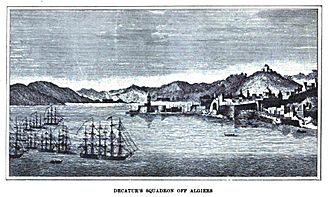
With the war against Britain over, the United States could focus on problems in the Mediterranean, specifically at Algiers. Just like before the First Barbary War, American merchant ships and crews were being captured. They were held for large ransoms. On February 23, 1815, President Madison asked Congress to declare war. Congress approved the action but did not officially declare war against Algiers. Madison chose Benjamin Williams Crowninshield as the new Secretary of the Navy.
Two squadrons were put together. One was in New York, commanded by Stephen Decatur. The other was in Boston, commanded by Commodore William Bainbridge. Decatur's squadron of ten ships was ready first. It sailed for Algiers on May 20. This was the largest U.S. fleet ever assembled at that time. Decatur commanded the flagship USS Guerriere. William Shaler was also on board. He was the consul-general for the Barbary States. He acted as a commissioner with Commodores Decatur and Bainbridge. Shaler had a letter from Madison. It allowed them to negotiate peace with the Algerian government. Because of Decatur's success in the War of 1812 and his knowledge of the Algerian port, Crowninshield chose him to lead the squadron.
The U.S. demanded the release of American prisoners. They also wanted an end to annual tribute payments. And they wanted fair agreements for captured ships. Decatur was ready to negotiate peace or use military force. Eager to know the Bey's decision, Decatur sent the president's letter. This letter made the Bey stop his piracy and kidnapping. He agreed to terms with the United States.
Commanding the USS Guerriere
On May 20, 1815, Commodore Decatur received orders from President James Madison. He was to command the frigate USS Guerriere. He would lead a squadron of ten ships to the Mediterranean Sea. Their mission was to end the practice of paying tribute to the Barbary pirate states. His squadron arrived at Gibraltar on June 14.
Before going into the Mediterranean, Decatur got information from American consuls. They were in Cadiz and Tangier. They told him about any squadrons passing by. To keep his squadron's presence a secret, Decatur did not enter the ports. Instead, he sent a messenger in a small boat to talk with the consuls. He learned that a squadron led by the famous Rais Hamidou had passed into the Mediterranean. Decatur's squadron arrived at Gibraltar on June 15, 1815. This attracted a lot of attention. Several ships were sent to warn Rais about the squadron's arrival. Decatur's visit with the consul was short. He quickly sent a letter to the Secretary of the Navy. He informed him of earlier weather problems and said he was about to "proceed in search of the enemy forthwith." He immediately set off to find Hamidou, hoping to surprise him.
On June 17, while sailing in Guerriere for Algiers, Decatur's fleet met two Algerian ships near Cape Palos. These were the frigate Mashouda, commanded by Hamidou, and the brig Estedio. Both were on their way to Algeria. Decatur's ship caught up to the Mashouda. He fired two broadsides, badly damaging the ship. Thirty crew members were killed, including Hamidou himself. More than 400 prisoners were taken. Lloyd's List reported that the Algerian frigate Mezoura had arrived at Carthagena on June 20 as a prize for Decatur's squadron. The newspaper also said that Decatur's squadron had forced another Spanish frigate ashore near Carthagena.
By capturing the flagship of the Algerian fleet at the Battle off Cape Gata, Decatur gained power to negotiate with the Dey of Algiers. When he arrived, Decatur showed an early use of gunboat diplomacy. He reminded the Dey that force was the only option if he refused to sign a treaty. As a result, a new treaty was agreed upon within 48 hours of Decatur's arrival. This confirmed the success of his goals.
After making peace with Algiers, Decatur's squadron sailed to Tunis and Tripoli. He demanded money back that those governments had kept during the War of 1812. With a similar show of force, Decatur got everything he demanded. He promptly sailed home victorious. Upon his arrival, Decatur proudly told the Secretary of the Navy that the settlement had "been dictated at the mouths of our cannon." For this campaign, he became known as "the Conqueror of the Barbary Pirates".
Life at Home
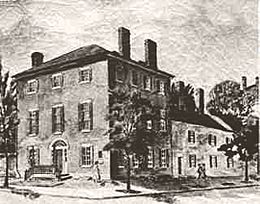
After his victory in the Mediterranean, Decatur returned to the United States. He arrived in New York on November 12, 1815. He was met with a warm welcome from important people and citizens. Among the notable greetings was a letter from Secretary of State James Monroe. It said, "I take much interest in informing you that the result of this expedition, so glorious to your country and honorable to yourself and the officers and men under your command, has been very satisfactory to the President."
The Secretary of the Navy, Benjamin Williams Crowninshield, was also very grateful. There was an opening on the Board of Navy Commissioners. The Secretary was eager to offer the position to Decatur, who gladly accepted. Upon his appointment, Decatur traveled to Washington. There, he was again welcomed warmly. He served on the Board of Navy Commissioners from 1816 to 1820. One of his important decisions as a commissioner was strongly opposing the return of James Barron to command. Barron had been banned from command for five years after his handling of the Chesapeake. This opposition would later lead to Barron challenging him to a duel.
While serving as a Commissioner, Decatur also became active in Washington's social life.
His Home in Washington
Now that Decatur was a Naval Commissioner, he settled into a routine life in Washington. He worked at the Navy Department during the day. Many evenings were spent at social gatherings. Both he and his wife were very popular in Washington society.
Decatur's first home in Washington was at 1903 Pennsylvania Avenue. He bought it in 1817. In 1818, Decatur built a three-story red brick house in Washington. It was on Lafayette Square. The famous English architect Benjamin Henry Latrobe designed it. He also designed the U.S. Capitol building. Decatur wanted his house to be suitable for "impressive entertainments." His house was the first private home built near the White House.
Decatur House is now a museum. It has a large collection of Decatur's belongings. The National Trust for Historic Preservation manages it. The house was built in a grand style to host large social events. These were almost a regular part of Decatur's and his wife's lives after his many naval victories.
Decatur's Death
Stephen Decatur's life and great service in the U.S. Navy ended early. In 1820, Commodore James Barron challenged Decatur to a duel. This was partly because of comments Decatur had made about Barron's actions in the Chesapeake–Leopard affair of 1807. Barron had lost the Chesapeake to the British. He faced a court-martial and was banned from command for five years. Decatur had been part of the court-martial that found Barron guilty of "unpreparedness."
Barron had just returned to the United States from Copenhagen. He had been away for six years and wanted to be reinstated. Many naval officers criticized him. Decatur was one of the most outspoken. Decatur was on the Board of Naval Commissioners. He strongly opposed Barron's reinstatement. He was very critical about it in talks with other officers and government officials. As a result, Barron became angry with Decatur and challenged him to a duel.
Dueling between officers was common at the time. It was causing a shortage of experienced men. The Department of the Navy even threatened to fire those who dueled.
Barron's assistant was Captain Jesse Elliott. Elliott was known for being boastful and against Decatur. Decatur first asked his friend Thomas Macdonough to be his second (assistant in a duel). But Macdonough refused because he was always against dueling. Decatur then asked Commodore William Bainbridge, who he thought was his friend. Bainbridge agreed. However, some historians believe Bainbridge was jealous of the younger, more famous Decatur.
The seconds met on March 8 to set the time, place, and rules for the duel. The arrangements were very specific. The duel would take place at 9:00 AM on March 22. It would be at Bladensburg Dueling Grounds, near Washington. The distance would be only eight paces. Decatur was an expert pistol shot. He planned only to wound Barron in the hip.
Decatur did not tell his wife, Susan, about the duel. Instead, he wrote to her father. He asked him to come to Washington to stay with her. His words hinted that he was facing a duel and might die. On the morning of the 22nd, the dueling party gathered. The two seconds talked for 45 minutes. Just before the duel, Barron spoke to Decatur about making peace. However, the seconds did not try to stop the duel.

Bainbridge and Elliott arranged the duel in a way that made it very likely both men would be wounded or killed. The shooters stood close to each other, face to face. There was no walking away and turning to fire, which often resulted in missing. When they were in place, Bainbridge instructed them, "I shall give the word quickly – 'Present, one, two, three' – You are neither to fire before the word 'one', nor after the word 'three'." Each man raised his pistol, cocked it, aimed, and stood in silence. Bainbridge called out, 'One'. Decatur and Barron both fired before the count of 'two'.
Decatur's shot hit Barron in the lower stomach and bounced into his thigh. Barron's shot hit Decatur in the hip area, cutting arteries. Both men fell almost at the same time. Decatur, badly wounded and holding his side, cried out, "Oh, Lord, I am a dead man." Lying wounded, Commodore Barron (who survived) said the duel was fair and honorable. He told Decatur he forgave him.
Other men who knew about the duel arrived. This included Decatur's friend and mentor, John Rodgers. In terrible pain, Decatur was carefully lifted by surgeons. He was placed in Rodgers' carriage and taken back to his home on Lafayette Square. Before leaving, Decatur called out to Barron, saying he should also be taken along. But Rodgers and the surgeons shook their heads. Barron cried back, "God bless you, Decatur." With a weak voice, Decatur called back, "Farewell, farewell, Barron."
Upon arriving home, Decatur was taken into the front room. He insisted his wife and nieces be taken upstairs. He wanted to spare them the sight of his serious condition. A doctor arrived to help the naval doctors. However, for reasons not fully clear, Decatur refused to have the bullet removed from his wound. At this point, Decatur asked for his will to be brought. He signed it, giving all his possessions to his wife. He also named the executors of his will. Decatur died around 10:30 PM that night. While wounded, he is said to have cried out, "I did not know that any man could suffer such pain!"
Washington society and the nation were shocked. Decatur had been killed at age 41 in a duel with a rival navy captain. Decatur's funeral was attended by Washington's elite. This included President James Monroe and Supreme Court justices. Most of Congress was also there. Over 10,000 citizens attended to pay their respects to a national hero.
The pallbearers were Commodores Rodgers, Chauncey, Tingey, Porter, and Macdonough. Also Captains Ballard and Cassin, and Lieutenant Macpherson. Naval officers and sailors followed. At the funeral, a grieving sailor came forward and said, "He was the friend of the flag, the sailor's friend; the navy has lost its mainmast." Stephen Decatur died without children. He left his widow $75,000, a large fortune at the time. But she died almost penniless in 1860. She received a small yearly payment from a donation she made to Georgetown College. Later, she received a small monthly pension from Congress.
Decatur's body was buried in the Barlow family vault at Kalorama. This was according to Susan's wish. It was later moved to Philadelphia. He was buried at St. Peter's Churchyard in 1846, next to his parents.
After the funeral, rumors spread. Some said there was a last-minute talk between the duelists that could have stopped the fight. Others thought the seconds might have planned for the deadly outcome. Decatur's widow, Susan, believed this even more strongly. She spent much of her life trying to get justice for what she called "the assassins."
Decatur's widow, Susan, tried for several years to get a pension from the U.S. Government. On March 3, 1837, Congress granted her a pension. It was retroactive to Decatur's death.
Legacy and Remembrance
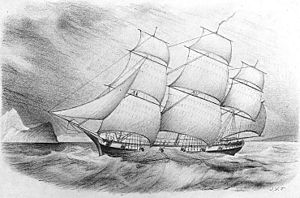
Even though he died young, Stephen Decatur helped shape the young United States. He played a big part in building its identity. Because of his bravery in the Barbary Wars and the War of 1812, Decatur became a symbol of American naval history. Most people admired him greatly.
Here are some ways Stephen Decatur is remembered:
- The Congressional Gold Medal was awarded to him on January 29, 1813. This honored his capture of HMS Macedonian by USS United States.
- Five U.S. Navy ships have been named USS Decatur.
- Franklin D. Roosevelt asked the U.S. Post Office Department to issue stamps honoring the U.S. Navy. Decatur was one of the few naval heroes chosen. He appeared on the 2-cent stamp with Thomas Macdonough.
- A picture of Decatur is on the Series of 1878/1880 $20 silver certificates.
- His last house in Washington, D.C., is now a museum. The National Trust for Historic Preservation owns it.
- At least 46 towns and cities in the United States are named after Stephen Decatur. These include Decatur, Alabama, Decatur, Georgia, Decatur, Illinois, and Decatur, Texas.
- Seven counties in the United States are named after Stephen Decatur. These include Decatur County, Georgia, Decatur County, Indiana, Decatur County, Iowa, Decatur County, Kansas, and Decatur County, Tennessee.
- The town of Doylestown, Pennsylvania, has a street named after him.
- Decatur Avenue in Norman, Oklahoma, is named in his honor. So is Decatur Avenue in the Bronx, New York. Decatur Boulevard is in Las Vegas. Decatur Street is in Mineral Point and Omaha. Decatur Avenue is in Minneapolis, Minnesota.
- Decatur Avenue in Eaton, Ohio, is named after him. Eaton is the county seat of Preble County, which is named after Edward Preble, Decatur's commander during the Second Battle of Tripoli Harbor.
- Decatur Street is also a street in Brooklyn, New York City.
- In Worcester County, Maryland, where he was born, a street, monument, park, and high schools are named after him. His birthplace is marked in the town of Berlin, Maryland.
- A main street in New Orleans' French Quarter is named Decatur in his honor.
- An island in the San Juan Archipelago (Washington state) is named Decatur Island.
- Decatur Township, in Van Buren County, Michigan, and Decatur Township, in Clearfield County, Pennsylvania are named in his honor.
- One of his family's descendants is the opera singer Florence Kirk.
- C. D. Howe, a Canadian cabinet minister, is related to him through his mother.
Images for kids
See also
 In Spanish: Stephen Decatur para niños
In Spanish: Stephen Decatur para niños
- History of the United States Navy
- List of United States Navy people
- List of sailing frigates of the United States Navy


